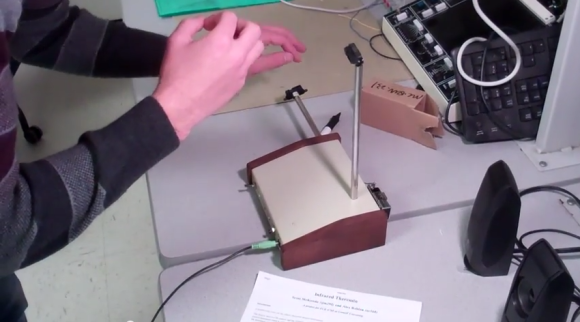
At the end of every semester, we get a bunch of cool and well-documented student projects from Cornell’s ECE4760 class. [Scott] and [Alex]’s infrared theremin is no exception.
The classic theremin design employs each of the player’s hands as the grounded plate of a variable capacitor in an LC circuit. For the pitch antenna, this circuit is part of the oscillator. For the volume antenna, the hand capacitor detunes another oscillator, changing the attenuation in the amplifier.
[Scott] and [Alex] put a twist on the theremin by using two IR sensors to control volume and pitch. The sensors compute the location of each hand and output a voltage inversely proportional to its distance from the hand. An ATMega1284P converts the signal to an 8-bit binary number for processing. They built four voices into it that are accessible through the push-button switch. The different voices are created with wave combinations and modulation effects. In addition to Classic Theremin, you can play in pure sine, sawtooth, and FM modulation.
If you’re just not that into microcontrollers, you could build this digital IR theremin instead. If you find IR theremins soulless or plebeian, try this theremincello.
[Thanks Bruce]















I’m not a big fan of this project. You need really high accuracy when playing a theremin; IR distance sensors just can’t be used. Also, IR distance sensors have a minimum distance to work, so placing your hand on the volume sensor doesn’t silence it, and this is important to have. Even programming wasn’t done well. Why does the micro-controller have to compute the look-up table each boot? Why can’t it already be stored in memory?
sounds and looks like their volume sensor needs to be calibrated to a higher sensitivity. Otherwise looks and sounds great guys! You should totally put a 2.5mm jack for a foot-pedal that switches modes so it can be done on the fly.
well… not bad for a simple theremin
the smooth glissando is nice but does seem like it needs to be calibrated a bit better
I own and play a Moog Theremin and I could point out a lot of ways in which this isn’t a proper one, but I won’t because it looks quite nice, it gets the basic (first) sound right and adds to it. You can also hear some steps in the sound which would make it easier to play compared to the truly step-less range of a true Theremin. It can’t of course deal with finger settings, but for a basic feeling this could be a good trainer.